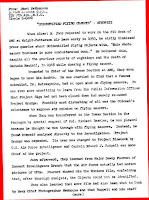




Al Chop's government service continued long after the motion picture, "U.F.O." first saw the light of day. Magnetically recorded on an old reel-to-reel tape among my clutter were a few precious seconds of Al Chop speaking to the nation as NASA's voice of mission control during a sixties space launch, and those few seconds of audio history now reside somewhere among Wendy Connors' Faded Discs collection.
Chop served NASA well as its deputy public affairs spokesman back then, and his influence appears in numerous newspaper articles of the era. A few national headlines reflecting his work are shown here, covering the years 1962-1966.
From 1962 -- Questions had been raised about astronaut John Glenn's noticeable absence from space agency activities (due to moving his family, Chop explained) and NASA's failure to promptly inform an anxious public that astronaut Scott Carpenter landed safely after his 1962 orbital flight. (Side note: Carpenter, incidentally, said a few interesting words about the UFO issue, reflected in the book, We Seven.)
In 1965, Chop spoke at a well-attended San Antonio conference on NASA's behalf, announcing that astronauts' photos from space had profoundly opened up new frontiers of scientific research. Later, as Christmas season approached at the Houston Space Center, an Air Force officer dressed as Santa Claus appeared, and Chop quipped to an Associated Press reporter that Santa "complained about our spacecraft up there and said he has almost hit them a couple of times."
After two consecutive failures in launching the Gemini 9 spacecraft in 1966, Chop kept the press informed, though NASA seemed initially at a loss to offer details. Despite some disappointed astronauts and engineers, however, all was not doom and gloom. When Gemini 9 finally soared into space, famed NBC news commentator Chet Huntley reported humorously about Chop's announcement (a gaffe) to the world that the craft was "three minutes and 60 seconds into the flight." Simply stating four minutes, according to Huntley's often dry wit, wouldn't fit in with the newly-emerging semantics of astronautic jargon.
Years later, Herb Lawrence of the Copley News Service questioned Chop about the impressive UFO reports he encountered as chief of the Pentagon's Air Force's press desk in the fifties, long before his NASA involvement. "Chop wouldn't say whether the Air Force felt they (UFOs) were spaceships from another planet," Lawrence wrote in 1972. "But he hinted broadly that he believed this."
(Thanks to Barry Greenwood for the news clippings)





































